League of Green Youth Ambassadors






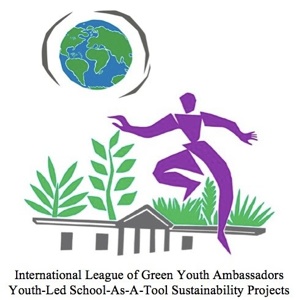
League of Green Student Ambassadors: Youth-Led, School-Based Sustainability Projects & International Youth Partnerships for a Sustainable 21st Century
Program Launch: The League of Green Student Ambassadors Debut – October 21, 2011
Les Respirations D’ Enghien-Les-Bains, France


France Comes to Boston


Touring Boston during Inaugural Youth Ambassadors Meeting with founding partners
Visiting the Food Project Green House with new partners from Notre Dame School in Enghien Les Bains, France

The program seeks to provide a vehicle for highlighting and sharing best practices in terms of sustainability projects initiated by participating students (Green Ambassadors) at schools around the globe & to provide a forum for green youth ambassadors to formulate a common school-based youth agenda for energy efficiency, renewable energy, and water conservation in schools around the world.
Green Student Ambassadors will:
1.Initiate School as A Tool Sustainability Projects at their respective schools
2.Partner with green ambassadors in a school in a country beyond their own, seeking when possible, to support one another’s School As Tool Sustainability
3.Share online information about their School As A Tool Sustainability Project and International Partnership (using the detail template for online sharing)
4.Participate in an annual virtual International Youth Sustainability Summit to share best practices and collaborate in formulating a common school-based international youth agenda for energy efficiency, renewable energy, water conservation, and educating for sustainability.
Boston Goes to France
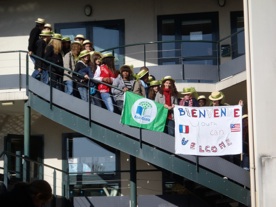
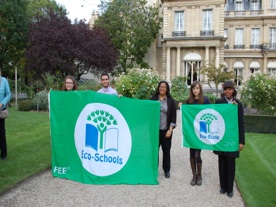
Students at Notre Dame in Enghien-Les-Bain Welcome BLS Youth CAN
League of Green Youth Ambassador Partner Schools Exchange Green Flags at the US Embassy in Paris
School As A Tool Projects

School As A Tool Project Scope & Criteria
1.Goals: Projects should serve to directly improve sustainability as well as to function as demonstration projects that help educate about sustainability.
2.Impact: Projects should positively impact the school community as well as having community outreach & partnering components.
3.Leadership: Projects should be primarily student-led, but include meaningful adult support
4.Topics: Sustainability projects might include but are not be limited to students addressing such issues as: air, water, energy, food, transportation, education, security, health, justice, equity, etc. Students could pursue natural resource protection, facilities or grounds improvement projects, efficiency initiatives, etc. Students might host educational fairs & teach-ins, or undertake clean up or conservation actions. There are unlimited possibilities for projects. Some might involve smaller goals like school recycling programs, energy audits, and school gardens. Others may entail larger goals such as community-wide initiatives that will promote sustainability.
Support
The Green Student Ambassadors program will support student-led education for sustainability projects in schools and communities by providing a venue for highlighting and sharing information about School As A Tool Sustainability projects; encouraging international partnering and collaboration among green student ambassadors; and helping student ambassadors gain local, national, and international support for their initiatives.
International Partnerships & Collaboration
The Green Students Ambassadors Program website will provide a forum both for online posting of student projects, as well as a forum for international partnering among student ambassador projects and for developing a common agenda for energy efficiency, renewable energy, and water conservation. Ambassadors with active School As A Tool Sustainability Projects underway (projects posted online) will be able to “invite” a distant group to partner with them, share ideas, and collaborate towards furthering the goals of their respective projects. Partnering groups will be asked to document the partnership and details of the collaboration and will be highlighted with a link to their collaboration on the League of Green Student Ambassadors home page.
Green Student Ambassadors will be asked to participate in international online discussion boards to formulate the common energy agenda.
Detail Template for Online Sharing of School As A Tool Sustainability Projects
1.Name of Project, Name of School, Address of School (including country)
2.Describe your project: Outcome and Effects
a.Identify the main sustainability goal of your project (eg. Explain the primary outcome you hope to achieve)
b.Explain how achieving your goal will contribute in some important way to improved sustainability (please be specific about the effects that achieving your goal will have on future sustainability)
c.List the major steps you took to start your project
d.Beneficiaries – identify who/what will your project directly benefit or serve
e.Numbers Impacted – estimate the number people your project will benefit/serve/impact
f.Upload some pictures with captions show some of your work
3.Educating for Sustainability Goals:
a.Explain how your project specifically involves/educates/changes the behaviors of others with regard to sustainability?
b.Identify the major steps/activities/programs you’ve undertaken in your effort to promote the project within your school community
c.Identify the major steps/activities/programs you’ve undertaken in your effort to promote the project with individuals and organizations in the broader community (beyond your school)
4.Project Promotion & Support
a.List the number of students involved in promoting the project
b.List (separately) the number of faculty, administrators, parents, community members, and public officials who you have engaged in support of the project
c.List any public officials, organizations, etc. who you are working with to achieve your goals
d.Describe how you made contact with and enlisted the help of project supporters within your school
e.Describe how you made contact with and enlisted the help of project supporters outside of your school
5.Project Evaluation
a.List 3 highlights/successes you’ve had so far with the project
b.List 3 major steps you’d still like to accomplish
6.International Partners
a.Identify any project(s) internationally that your project is actively partnering with
b.Explain how you identified your partner
c.Describe what you have gained & contributed as a result of the partnership
7.Support
a.How Can the League of Green Student Ambassadors help support your project (what do you need to make it work – be specific)?
Definitions of Sustainability http://www.nps.gov/sustain/spop/def.html
Some believe that adopting a sustainable approach means increasing recycling, reducing waste, and selecting "green" products. While these are important steps, they fail to address the fundamental problems. Ecosystems do not, and cannot, expand their life-sustaining capacities in response to the expanding desires of cultures or exploding global populations. We must, instead, look within ourselves as we move towards a sustainable life. Hopefully, the following definitions, taken from a variety of sources will help you to determine your own view of sustainability:
"Sustainable design is the set of perceptual and analytic abilities, ecological wisdom, and practical wherewithal essential to making things that fit in a world of microbes, plants, animals, and entropy. In other words, (sustainable design) is the careful meshing of human purposes with the larger patterns and flows of the natural world, and careful study of those patterns and flows to inform human purposes."
-David Orr, Ecological Literacy
"A sustainable society is one which satisfies its needs without diminishing the prospects of future generations."
Lester R. Brown, Founder and President, Worldwatch Institute
"Sustainability is equity over time.": "As a value, it refers to giving equal weight in your decisions to the future as well as the present. You might think of it as extending the Golden Rule through time, so that you do unto future generations as you would have them do unto you." "
-Robert Gilman, Director, Context Institute
"A transition to sustainability involves moving from linear to cyclical processes and technologies. The only processes we can rely on indefinitely are cyclical; all linear processes must eventually come to an end."
-Dr. Karl Henrik-Robert, MD, founder of The Natural Step, Sweden
"Actions are sustainable if:
¥There is a balance between resources used and resources regenerated.
¥Resources are as clean or cleaner at end use as at beginning.
¥The viability, integrity, and diversity of natural systems are restored and maintained.
¥They lead to enhanced local and regional self-reliance.
¥They help create and maintain community and a culture of place.
¥Each generation preserves the legacies of future generations."
-David McCloskey, Professor of Sociology, Seattle University
"Clean air, clean water, safety in city parks, low-income housing, education, child care, welfare, medical care, unemployment (insurance), transportation, recreation/cultural centers, open space, wetlands..."
-Hazel Wolf, Seattle Audubon Society
"A thing is right when it tends to preserve the integrity, stability, and beauty of the biotic community. It is wrong when it tends otherwise."
-Aldo Leopold, A Land Ethic, from Sand County Almanac
"Leave the world better than you found it, take no more than you need, try not to harm life or the environment, make amends if you do. "
- Paul Hawken, The Ecology of Commerce
Download our Photo Powerpoint as a PDF here.
Photos of Our Trip to France

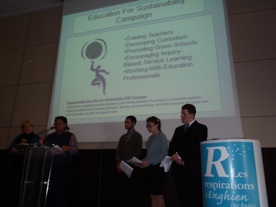
Auvers-sur-Oise where Van Gogh painted
Youth CAN Presenting at Les Respirations
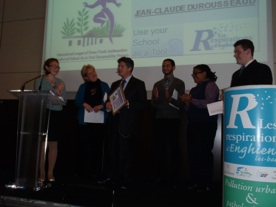
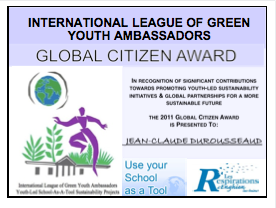
Presenting our Host, Jean Claude Durousseaud with our Global Citizen Award
Global Citizen Award 2011


BLS Youth CAN Presents at the Oxygen Awards
At the Eiffel Tower
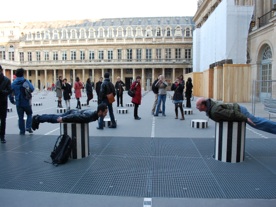
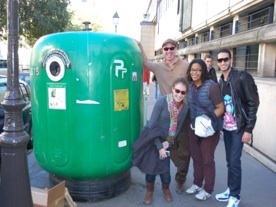
Planking in Paris with a Boston City Official
Checking out Green Features in Paris
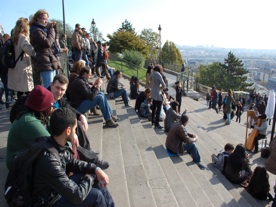
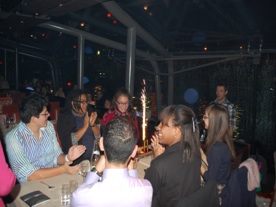
Overlooking the City of Lights from Sacre Coeur
On the Dinner Cruise Boat

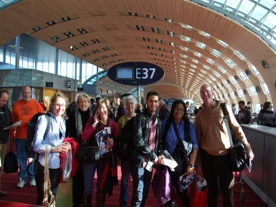
On the Plane to France
On Our Way Home





